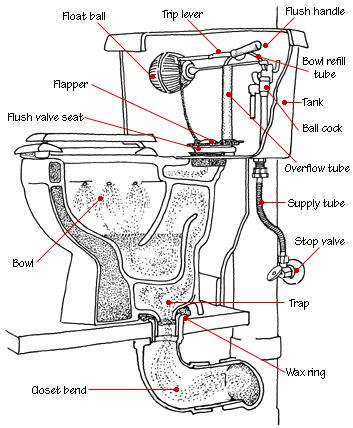|
So you pushed the lever, the toilet has filled and now all you've got is a bowl full of troubles.
What do you do? This article will go over how toilets work, fixes you can try for clogs and when to call a professional. How a toilet works: A toilet has two main parts: the tank and the bowl. The tank houses the flush/refill mechanism and water for flushing (1.28 gallons for high efficiency toilets, all the way up to 7(!!!!) gallons for older toilets). The hole at the bottom of the bowl connects to a siphon tube and eventually to a 4" drain that goes out to the sewer line. The siphon tube curves up and then down again (it's that intestine-y looking thing on the side of the toilet base). In order to flush the toilet, enough water must be added to the bowl to flow over the upward curve of the siphon tube. This action sucks everything from the bowl into the sewer pipe. Want more detail on how flushing works? Here's a quote from writer Philip Schmidt, from his article about troubleshooting your toilet's flushing mechanism: "A toilet's flush action is powered by three things: water pressure, gravity and you (the Flush Master). The big tank at the back of the bowl is full of water, and it's elevated above the bowl. When the Flush Master activates the handle, it pulls on a chain inside the tank, which in turn lifts a little rubber trap door (called a flapper). This lets the water in the tank rush down through a big hole and into the bowl, creating the familiar swirling action and, ultimately, the flush that empties the bowl. When the tank is empty, the flapper drops back down over the hole. Meanwhile, a float that's attached to the flush-and-fill valve (also called a "ballcock") has dropped with the exiting water, triggering the valve to open and refill the tank. The float rides atop the rising water and shuts off the valve at the preset level." Ok, this is great and all but...my floor is still in danger of being wet. In general, if you're toilet isn't flushing, it is likely one of two issues. Either there's a problem with the flush mechanism itself, or there is a problem with the drainage system (aka: a clog). If the toilet flushes (ie: the bowl fills with water but it's not going anywhere), then you've got a drainage issue. Since the bowl is full, you've probably come to this conclusion yourself. So what now? First, if the toilet is in danger of overflowing, remove the lid of the tank and seal the hole at the bottom of the tank with the flapper. This will stop more water from entering the bowl. You may need to get your hand wet to do this. Don't worry. This water is straight from the line and has not cycled into your toilet yet (only the tank). If this doesn't work for whatever reason, locate the supply line behind the toilet and turn the stop valve to "off." This will prevent water from coming from the line into the tank. (If you have to take this step, give us a call right away.) Next: get a plunger and go to work. Make sure the flange on the plunger completely covers the hole at the bottom of the bowl. Make a good seal and push down as much as you can, then pull up. Try this a few times, then flush the toilet. If it doesn't work, try once more. If this still doesn't work, you have a choice to make. Option 1: if you own a toilet auger, it's time to break it out. These dudes are the little brothers of drain snakes used by professional plumbers. They are about 6' long and cost around $50. To use it, insert the auger head into the drain and feed the cable further into the drain by cranking the handle and pushing down on it. Keep cranking the handle after you've broken through the clog to make sure you completely clear the blockage. This can be easy to do, or it can take a lot of pressure if you have a major blockage. If you've broken through the blockage, you should be able to flush the toilet successfully. If not, then there's always Option 2. Option 2: If you don't have a toilet auger or if the idea of using one does not appeal to you, give us a call. We are happy to help.
0 Comments
Your comment will be posted after it is approved.
Leave a Reply. |
AuthorCommunity Plumbing is a local San Diego plumber serving residential and commercial properties. Archives
January 2018
Categories |


 RSS Feed
RSS Feed